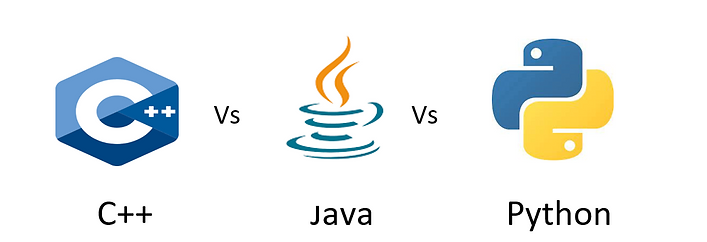Difference between C ,C++, Python & Java
3 min read
3d illustration text of java on abstract background
Difference between C ,C++, Python & Java .When it comes to choosing a programming language for your project, the vast number of options can make the decision overwhelming. Each language has its strengths and is better suited for particular use cases. In this article, we’ll explore four of the most popular programming languages: C, C++, Python, and Java. We’ll compare them side-by-side in terms of features, performance, usability, and more, so you can make a more informed choice for your next development project.
Below is a comparison table that highlights the key differences between C, C++, Python, and Java across various important parameters.
| Feature | C | C++ | Python | Java |
|---|---|---|---|---|
| Paradigm | Procedural | Multi-paradigm (Procedural, OOP) | Multi-paradigm (OOP, Functional) | Object-oriented (OOP) |
| Syntax | Simple, low-level | Complex (supports OOP features) | High-level, easy to read | High-level, similar to C++ |
| Memory Management | Manual (malloc/free) | Manual (new/delete) | Automatic (Garbage Collection) | Automatic (Garbage Collection) |
| Performance | Fast (close to hardware) | Fast (with OOP overhead) | Slower (due to interpretation) | Fast (with JVM optimizations) |
| Compilation/Interpretation | Compiled | Compiled | Interpreted | Compiled to bytecode, runs on JVM |
| Platform Dependency | Platform-dependent | Platform-dependent | Platform-independent | Platform-independent (via JVM) |
| Memory Safety | No built-in protection | No built-in protection | Built-in memory safety | Built-in memory safety |
| Use Cases | System programming, OS, Embedded systems | Game development, GUI, system programming | Web development, scripting, AI/ML, data analysis | Enterprise apps, mobile apps, web services |
| Inheritance | Not supported | Supported (Multiple inheritance with classes) | Supported (single inheritance with classes, multiple inheritance with mix-ins) | Supported (Single inheritance) |
| Library Support | Limited standard library | Extensive standard library | Extensive standard library | Extensive standard library |
| Pointers | Fully supported | Supported | Not supported | Not supported |
| Concurrency Support | Low-level (threads) | Low-level (threads) | High-level (threads, asyncio) | Built-in concurrency support |
| Learning Curve | Steep | Steep | Easy to moderate | Moderate |
| Object-Oriented | No | Yes | Yes | Yes |
| Extensibility | Hard to extend | Easier with OOP features | Highly extensible | Highly extensible |
C: The Foundation of Modern Programming
C is one of the oldest high-level programming languages and is often regarded as the foundation of modern programming. Developed in the 1970s, C is a procedural language that provides direct access to memory via pointers, making it extremely powerful for low-level programming like operating systems and embedded systems.
- Strengths: Blazing fast due to close-to-hardware nature, minimal runtime overhead.
- Weaknesses: No memory safety, manual memory management, and steep learning curve.
C++: Adding Power Through Object-Oriented Programming
C++ builds on C by introducing Object-Oriented Programming (OOP), making it more versatile while maintaining the low-level functionality of C. It supports multiple paradigms, making it ideal for systems software, game development, and real-time applications.
- Strengths: Supports both procedural and object-oriented programming, more robust library support than C.
- Weaknesses: More complex syntax, manual memory management can lead to errors.
Python: Simplicity and Power for Modern Development
Python is an interpreted, high-level programming language that emphasizes code readability and developer productivity. It’s widely used in web development, data science, AI/ML, automation, and scripting.
- Strengths: Easy to learn and use, large standard library, automatic memory management, highly versatile.
- Weaknesses: Slower than C/C++ and Java, due to being interpreted.
Java: Cross-Platform and Enterprise-Ready
Java is an object-oriented language that is best known for its cross-platform capabilities via the Java Virtual Machine (JVM). It’s heavily used in enterprise applications, web services, and Android mobile development.
- Strengths: Cross-platform, automatic garbage collection, robust standard library.
- Weaknesses: Verbose syntax, can be slower compared to C++ in certain scenarios.
Choosing the Right Language for Your Project
Each language in the table above has its own unique advantages and trade-offs. Here are some recommendations based on your needs:
- System Programming and Performance-Intensive Applications: C or C++ are your best bets.
- Web Development, Scripting, and Data Science: Python is often the go-to choice.
- Enterprise-Level Applications and Mobile Development: Java shines in these areas.
Choosing the right language depends on the nature of the project, performance needs, and your familiarity with the language. Understanding these key differences can help you make a more informed decision.
Feel free to use the table above for quick reference whenever you’re deciding on the best language for your next project.
Also Read:-
Tech Jobs That Doesn”t Require Coding Knowledge
Top 10 C Language Projects for College Students in 2024
Top Python Projects 2024: Latest Innovations
How to Make Money on TikTok in 2024



